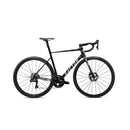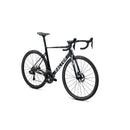- BENEFITS
- GEOMETRY
LIGHTNESS. SO MUCH LIGHTNESS.
The O2 VAM was born to climb, so it’s seriously light, from just 6.4kg out-of-the-box for a 54 with Shimano Dura-Ace Di2. Few disc brake bikes can compete and none of them are aero. Crucially, that figure means the pros can line up with a bike that’s still very close to the 6.8kg minimum once their pedals, cages, transponder and race number are added. One thing we all share with the pros is that when you’re about to take on thousands of metres of climbing, we want the lightest bike possible. The new O2 VAM uses ultra-high-grade materials, tube shapes optimized by super-computers for stiffness-to-weight, and a new manufacturing process so advanced that we built a whole new factory.
A WHOLE LOT OF AERO, TOO.
Why make an aero climbing bike? Firstly, because the climbs are only part of anyone’s ride and on the rest of any route it’s as important as ever to be aero. Secondly, because the pros climb so fast that aero remains a significant consideration even at typical gradients of 8%. Of course, everyone wants both lightness and low drag, but with aero shapes being heavier, the challenge for a climbing-focused bike is to save the most watts while adding the fewest grams. Our team nailed it. How aero is it? In the wind tunnel, at effective wind angles of 0-5 degrees (ie a calm day, or headwind to moderate crosswind) the new O2 VAM is only 5W behind the OSTRO VAM, which itself is the fastest aero bike on the market. Across a full sweep of angles, it slashes the gap by 50% versus the previous version. For such a light bike, that’s outrageous. On the road, it means that your climbing bike will be faster than many brands’ much heavier dedicated aero offerings.
STIFFNESS, HANDLING. CHECK. CHECK.
The new O2 VAM is as stiff as the mighty OSTRO VAM and feels inspirational when you stamp on the pedals. You’ll be attacking just to feel it. The handling geometry is shared, too, which means incredible poise at high speed on descents, confidence at big lean angles, and the agility to outmanoeuvre a house fly. After all, a bike for the mountains has to be great on the way down, too.


LIGHTNESS. SO MUCH LIGHTNESS.
The O2 VAM was born to climb, so it’s seriously light, from just 6.4kg out-of-the-box for a 54 with Shimano Dura-Ace Di2. Few disc brake bikes can compete and none of them are aero. Crucially, that figure means the pros can line up with a bike that’s still very close to the 6.8kg minimum once their pedals, cages, transponder and race number are added. One thing we all share with the pros is that when you’re about to take on thousands of metres of climbing, we want the lightest bike possible. The new O2 VAM uses ultra-high-grade materials, tube shapes optimized by super-computers for stiffness-to-weight, and a new manufacturing process so advanced that we built a whole new factory.
A WHOLE LOT OF AERO, TOO.
Why make an aero climbing bike? Firstly, because the climbs are only part of anyone’s ride and on the rest of any route it’s as important as ever to be aero. Secondly, because the pros climb so fast that aero remains a significant consideration even at typical gradients of 8%. Of course, everyone wants both lightness and low drag, but with aero shapes being heavier, the challenge for a climbing-focused bike is to save the most watts while adding the fewest grams. Our team nailed it. How aero is it? In the wind tunnel, at effective wind angles of 0-5 degrees (ie a calm day, or headwind to moderate crosswind) the new O2 VAM is only 5W behind the OSTRO VAM, which itself is the fastest aero bike on the market. Across a full sweep of angles, it slashes the gap by 50% versus the previous version. For such a light bike, that’s outrageous. On the road, it means that your climbing bike will be faster than many brands’ much heavier dedicated aero offerings.
STIFFNESS, HANDLING. CHECK. CHECK.
The new O2 VAM is as stiff as the mighty OSTRO VAM and feels inspirational when you stamp on the pedals. You’ll be attacking just to feel it. The handling geometry is shared, too, which means incredible poise at high speed on descents, confidence at big lean angles, and the agility to outmanoeuvre a house fly. After all, a bike for the mountains has to be great on the way down, too.






